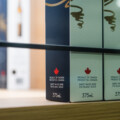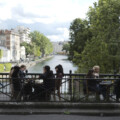The French saying “wine is food” carries two complementary meanings. First, that wine is both an agricultural product and an alimentary one, made with purpose and, one hopes, love. Second, that wine’s place is at the table and, while it complements what’s on the plate, is a constituent part of a meal to be savoured in its own right.
The “wine is food” theory is a good one to live by if one is looking for a deeper appreciation of what’s in one’s glass. Treating wine as food deliberately slows consumption and encourages contemplation. It’s also a good way to ensure moderation, by limiting imbibing to the time frame of a standard lunch or dinner.
Whether the wine is food theory works all that well in practice, at least on this side of the Atlantic, is more open to question. North Americans, and for that matter many Northern Europeans, tend to happily revert to barbaric ways and treat wine as a drink. In Canada, on a patio on a warm summer evening in the company of some friends a cool glass of white, or rosé, can be happily sipped standing up.
In my universe, wine as a drink applies more often to white. It’s simply more likely that a meal accompanied by white wine is going to be lunch, and for better or worse drinking at lunch is a rare treat. These days, wine at dinner is more common, but more likely red, even with fowl or fish.
The time and place for white wine is, more often than not, in the evening before dinner. My evidence is merely anecdotal, and speaks only to my “lived experience”, but in bourgeois circles, white wine is the favoured aperitif. It’s sipped with a few snacks, or maybe nothing at all.
I was a bit of a bore on this subject when I recently traveled to Languedoc and Roussillon in the South of France, as a guest of the joint consortium of wine producers from that region. In almost every case, if I tried one of the white wines, made with the typical grape varieties of the Pays d’Oc or Catalan, it held itself up on its own and would make a perfect aperitif.
The Languedoc and Roussillon are the parts of Mediterranean France west of the Rhône River, south of the Massif Centrale, and north of the Pyrenees. In the wine circles, this part of the world is best known for good value and powerful and fruit-forward red wines, made with grapes like Grenache, Carignan, Syrah, and Mourvèdre. Or, it’s known for light and refreshing rosé wines, made pale and bone dry.
It is not especially known for its white wines, with the possible exception of Picpoul-de-Pinet, which is something of an outlier. This is a shame, and if there is justice in the machinations of the world wine market, then the whites of the Languedoc and Roussillon will be the next big thing because they fill the role of a dry aperitif so well.
Maybe one of the reasons is that they are made from grapes that are unfamiliar to most wine consumers. For instance, I would be surprised if anyone in Toronto, Calgary, or Vancouver has ever asked a server for a glass of Bourboulenc. This is too bad, since Bourboulenc, which is the principal white grape of the La Cape, an appellation by the sea to the east of the Cathedral town of Narbonne, is delicious.
It’s more plausible that someone in Montreal has asked for a glass of Bourboulenc, though imagine the odds are against it because the grape is more often than not blended with others. In La Clape it would be Grenache Blanc, Viognier, or both. This could be another reason that marketing the white wines of the Languedoc and Roussillon is a challenge: there almost always made from a blend of grapes.
North American consumers retain a fondness for what the trade calls varietal wines, which means wines made from and named for one grape. A typical white wine choice might be: Chardonnay, Sauvignon Blanc, or Pinot Grigio?
The white wines of the South of France are made from tongue-twisting combinations that might include the aforementioned grapes, but also Roussanne, Marsanne, Grenache Gris, Clairette Blanche, and in Roussillon particularly the Blanc and Gris versions of Carignan and Vermentino (sometimes called Rolle). There’s a good reason for this.

Languedoc and Roussillon winemakers have been dealing with heat and drought since long before global warming made these enemies of the vine a threat everywhere. Blending multiple varieties of grapes was and is a sensible hedge. These Mediterranean varieties are designed to work together and complement each other. Some might offer a bit more acid, others a little more fruit.
The Mediterranean grape varieties also share a common desirable trait: the ability to withstand the heat long enough to mature and ripen fully. The result is that they make very easy-drinking wines that are dry but fruit-forward. Just the kind to sip at the aperitif hour as the day becomes evening.
The fruit spectrum on the white wines of Languedoc and Roussillon is from citrus to stone fruit, and core fruits too. There is often a gentle, aromatic note of white flower. They will also typically have a roundness and fullness of flavour that hits around the middle part of the tongue. And even in the driest wines a honey or honeysuckle.
Of course, these wines can also be enjoyed at the table, and make, in my opinion, an interesting and (usually) less oaky alternative to fuller styles of Chardonnay when paired with seafood or white meats. But they pair just as well with a bowl of olives and friendly chatter at the beginning of a warm summer evening.
Recommended for You

Matthew Grills: Joey Chestnut is America

Malcolm Jolley: The comfort of familiar favourites—or the fun of finding new wines?

Malcolm Jolley: An ‘Elbows Up’ wine project everyone can get behind

Malcolm Jolley: Need some summer wines? Look no further than the food-friendly, low-sugar sippers of the sunny Southern Rhône




